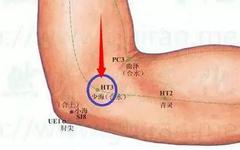1. Acupuncture Point: Xia Du (Extraordinary Point, one of the Eight Evils)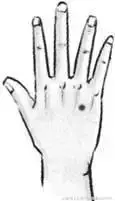 Location: Five fen above the tips of the fourth and fifth fingers on the back of the hand. Indication: Fever. Technique: Continuous pinching for1—2minutes.2. Acupuncture Point: Shao Hai (Hand Shao Yin Heart Meridian, He Point)
Location: Five fen above the tips of the fourth and fifth fingers on the back of the hand. Indication: Fever. Technique: Continuous pinching for1—2minutes.2. Acupuncture Point: Shao Hai (Hand Shao Yin Heart Meridian, He Point)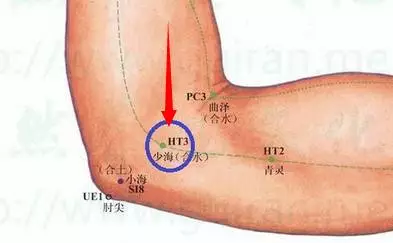 Location: Flex the elbow, at the midpoint of the line connecting the ulnar side of the elbow crease and the medial epicondyle of the humerus. Indication: Tachycardia. Technique: Knead for1-2minutes. (60-70/min) 3. Acupuncture Point: Tong Li (Hand Shao Yin Heart Meridian, Luo Point)
Location: Flex the elbow, at the midpoint of the line connecting the ulnar side of the elbow crease and the medial epicondyle of the humerus. Indication: Tachycardia. Technique: Knead for1-2minutes. (60-70/min) 3. Acupuncture Point: Tong Li (Hand Shao Yin Heart Meridian, Luo Point)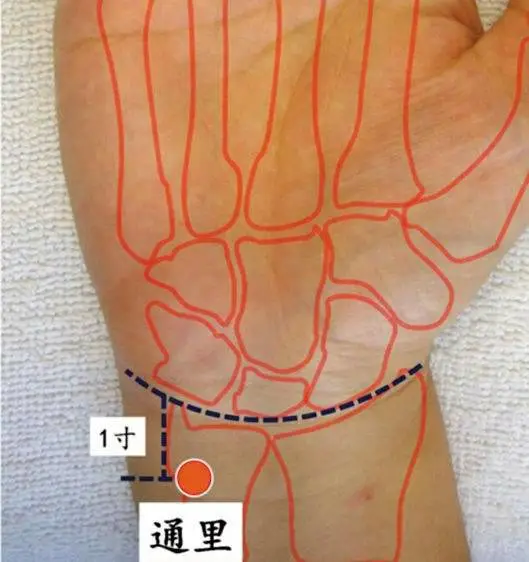 Location: One cun above Shen Men (Shen Men Point). Indication: Bradycardia. Technique: Press and knead for1—3minutes,300-500times. 4. Acupuncture Point: Da Ling (Hand Jue Yin Pericardium Meridian, Yuan Point)
Location: One cun above Shen Men (Shen Men Point). Indication: Bradycardia. Technique: Press and knead for1—3minutes,300-500times. 4. Acupuncture Point: Da Ling (Hand Jue Yin Pericardium Meridian, Yuan Point)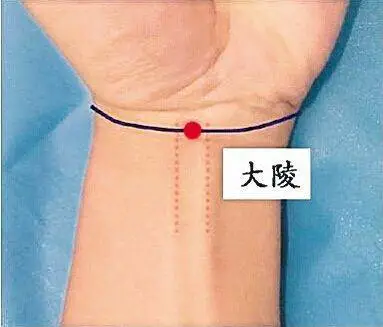 Location: At the center of the first transverse crease of the wrist on the palmar side, between the two tendons. Indication: Insomnia. Technique: Direct pressing for1—2minutes, pressing diagonally upwards. 5. Acupuncture Point: Shen Men (Hand Shao Yin Heart Meridian, Yuan Point)
Location: At the center of the first transverse crease of the wrist on the palmar side, between the two tendons. Indication: Insomnia. Technique: Direct pressing for1—2minutes, pressing diagonally upwards. 5. Acupuncture Point: Shen Men (Hand Shao Yin Heart Meridian, Yuan Point)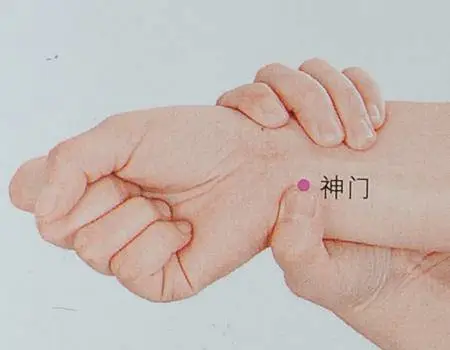 Location: In the depression above the ulnar side of the wrist crease. Indication: Hyperhidrosis. Technique: Direct pressing diagonally inwards for1—2minutes. 6. Acupuncture Point: Yong Quan (Foot Shao Yin Kidney Meridian, Jing Point)
Location: In the depression above the ulnar side of the wrist crease. Indication: Hyperhidrosis. Technique: Direct pressing diagonally inwards for1—2minutes. 6. Acupuncture Point: Yong Quan (Foot Shao Yin Kidney Meridian, Jing Point)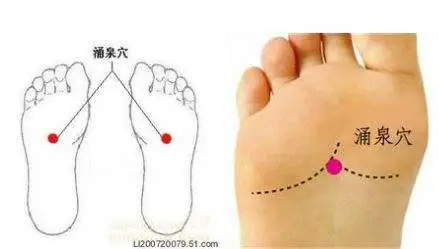 Location: At the junction of the anterior and middle third of the sole of the foot, where the foot is flexed and the toes curl. Indication: Heat in the soles of the feet. Technique: Knead36times. 7. Acupuncture Point: Mang Yu (Chong Meridian, Meeting Point of Foot Shao Yin)
Location: At the junction of the anterior and middle third of the sole of the foot, where the foot is flexed and the toes curl. Indication: Heat in the soles of the feet. Technique: Knead36times. 7. Acupuncture Point: Mang Yu (Chong Meridian, Meeting Point of Foot Shao Yin)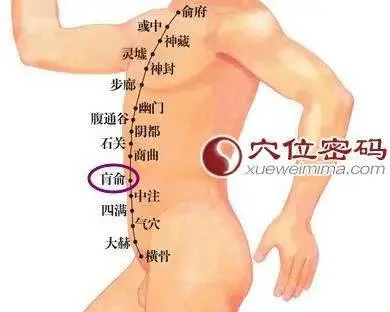 Location: Five fen lateral to the navel.Indication: Headache. Technique: Press with the thumb and middle finger, pressing diagonally upwards, left treats right, right treats left. 8. Acupuncture Point: Lie Que (Hand Tai Yin Lung Meridian, Luo Point, Meeting Point of Eight Meridians, connects to Ren Meridian)
Location: Five fen lateral to the navel.Indication: Headache. Technique: Press with the thumb and middle finger, pressing diagonally upwards, left treats right, right treats left. 8. Acupuncture Point: Lie Que (Hand Tai Yin Lung Meridian, Luo Point, Meeting Point of Eight Meridians, connects to Ren Meridian)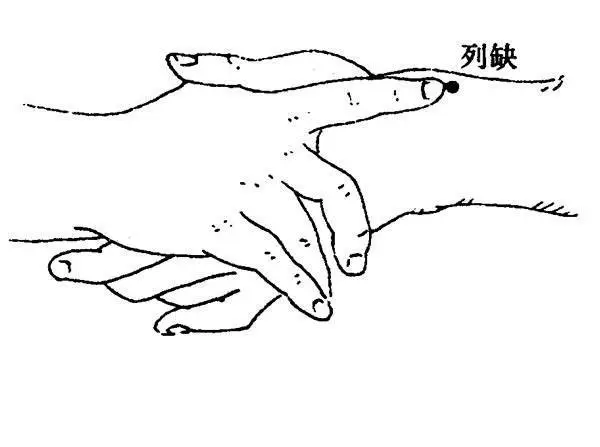 Location: When the thumbs of both hands cross, at the depression indicated by the index fingers. Indication: Pain at the top of the head. Technique: Direct pressing diagonally upwards. 9. Acupuncture Point: Xuan Zhong (Foot Shao Yang Gallbladder Meridian, Meeting Point of Eight Hui)
Location: When the thumbs of both hands cross, at the depression indicated by the index fingers. Indication: Pain at the top of the head. Technique: Direct pressing diagonally upwards. 9. Acupuncture Point: Xuan Zhong (Foot Shao Yang Gallbladder Meridian, Meeting Point of Eight Hui)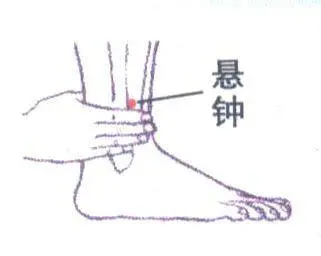 Location: Three cun directly above the tip of the outer ankle, at the posterior edge of the fibula. Indication: Migraine. Technique: Press and knead for3—6minutes, left treats right, right treats left. 10. Acupuncture Point: Ding Chuan (Hua Tuo’s Jia Ji)
Location: Three cun directly above the tip of the outer ankle, at the posterior edge of the fibula. Indication: Migraine. Technique: Press and knead for3—6minutes, left treats right, right treats left. 10. Acupuncture Point: Ding Chuan (Hua Tuo’s Jia Ji)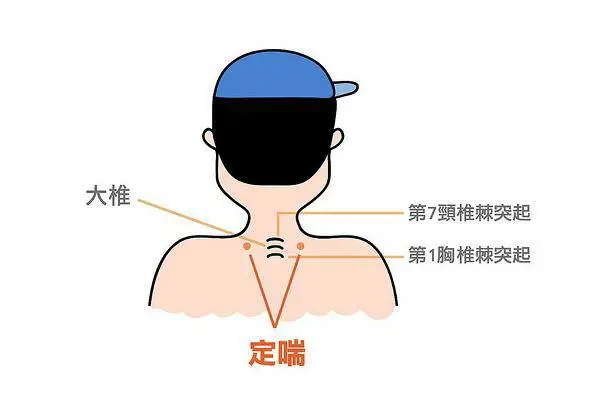 Location: Five fen lateral to the Dazhui (Da Zhui Point). Indication: Asthma. Technique: Press diagonally towards the shoulder for1-2minutes. 11. Acupuncture Point: Zhi Xie (On Ren Meridian, between Guan Yuan and Shi Men)
Location: Five fen lateral to the Dazhui (Da Zhui Point). Indication: Asthma. Technique: Press diagonally towards the shoulder for1-2minutes. 11. Acupuncture Point: Zhi Xie (On Ren Meridian, between Guan Yuan and Shi Men)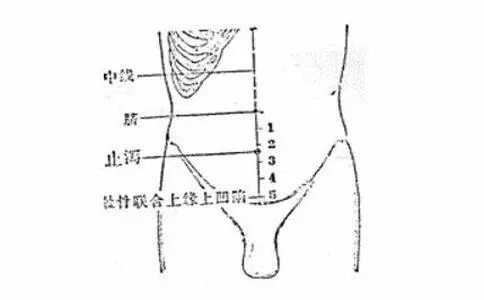 Location: Two and a half cun below the navel. Indication: Diarrhea. Technique: Direct pressing slightly diagonally upwards. 12. Acupuncture Point: Jiang Ya (On Foot Jue Yin Liver Meridian) Location: Between Da Dun and Tai Chong. Indication: Hypertension. Technique: Vibrate and press for1-2minutes.13. Acupuncture Point: Zu San Li (Foot Yang Ming Stomach Meridian; He Point, Lower He Point)
Location: Two and a half cun below the navel. Indication: Diarrhea. Technique: Direct pressing slightly diagonally upwards. 12. Acupuncture Point: Jiang Ya (On Foot Jue Yin Liver Meridian) Location: Between Da Dun and Tai Chong. Indication: Hypertension. Technique: Vibrate and press for1-2minutes.13. Acupuncture Point: Zu San Li (Foot Yang Ming Stomach Meridian; He Point, Lower He Point)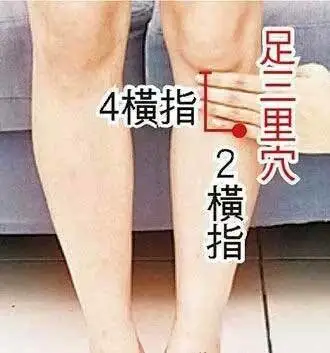 Location: Three cun below the outer knee eye, four horizontal fingers. Indication: Abdominal diseases, hyperlipidemia, stops stomach pain. Technique: Direct pressing diagonally downwards for1-2minutes. When experiencing stomach pain, use both thumbs to press and knead the Zu San Li point (located three cun below the knee, at the lateral side of the tibia) until a feeling of soreness and numbness occurs for3to5minutes, stomach pain can significantly reduce. 14. Acupuncture Point: Da Gu Kong (Extraordinary Point)
Location: Three cun below the outer knee eye, four horizontal fingers. Indication: Abdominal diseases, hyperlipidemia, stops stomach pain. Technique: Direct pressing diagonally downwards for1-2minutes. When experiencing stomach pain, use both thumbs to press and knead the Zu San Li point (located three cun below the knee, at the lateral side of the tibia) until a feeling of soreness and numbness occurs for3to5minutes, stomach pain can significantly reduce. 14. Acupuncture Point: Da Gu Kong (Extraordinary Point)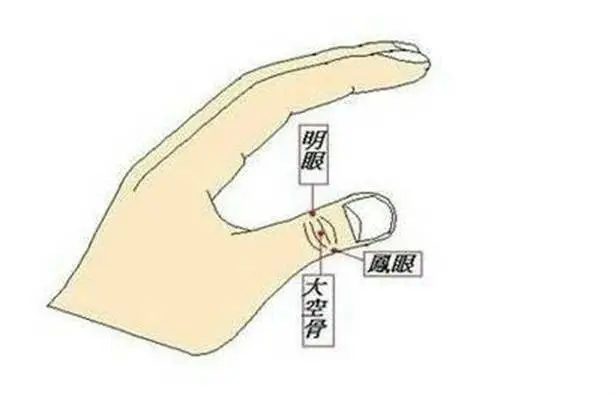 Location: At the midpoint of the transverse line connecting the proximal and distal phalanges of the thumb on the radial side. Indication: Cataracts. Technique: Use strong pressure to puncture, heavy technique is more effective. 15. Acupuncture Point: Shen Ting (Du Meridian)
Location: At the midpoint of the transverse line connecting the proximal and distal phalanges of the thumb on the radial side. Indication: Cataracts. Technique: Use strong pressure to puncture, heavy technique is more effective. 15. Acupuncture Point: Shen Ting (Du Meridian) 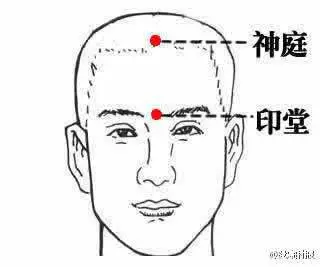 Location: 0.5 cun directly above the center of the forehead. Indication: Brain fatigue (to awaken the mind). Technique: Press and stimulate with the middle finger.16. Acupuncture Point: Xue Hai (Foot Tai Yin Spleen Meridian)
Location: 0.5 cun directly above the center of the forehead. Indication: Brain fatigue (to awaken the mind). Technique: Press and stimulate with the middle finger.16. Acupuncture Point: Xue Hai (Foot Tai Yin Spleen Meridian) 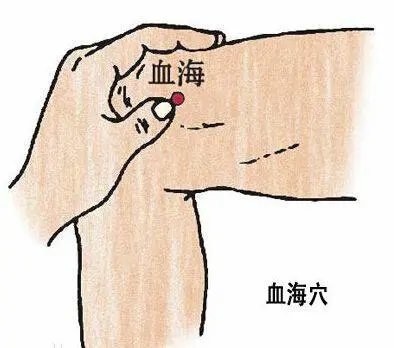 Location: Two cun above the inner upper edge of the patella. Indication: Eyelid edema. Technique: Strong pressure with the thumb. 17. Acupuncture Point: Jian Tong (Foot Yang Ming Stomach Meridian)
Location: Two cun above the inner upper edge of the patella. Indication: Eyelid edema. Technique: Strong pressure with the thumb. 17. Acupuncture Point: Jian Tong (Foot Yang Ming Stomach Meridian)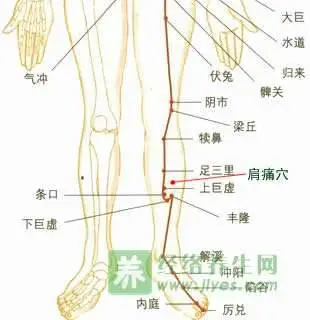 Location: About three cun below Zu San Li, at the edge of the tibia. Indication: Shoulder periarthritis. Technique: Strong pressure for1-2minutes, left treats right, right treats left.18. Acupuncture Point: Niu Shang (Extraordinary Point)
Location: About three cun below Zu San Li, at the edge of the tibia. Indication: Shoulder periarthritis. Technique: Strong pressure for1-2minutes, left treats right, right treats left.18. Acupuncture Point: Niu Shang (Extraordinary Point)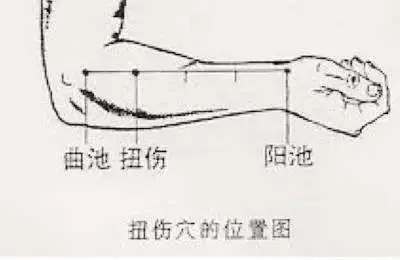 Location: At the intersection of the upper 1/4 and lower 3/4 of the line connecting Qu Chi (Hand Yang Ming Large Intestine Meridian) and Yang Chi (Hand Shao Yang San Jiao Meridian). Indication: Acute lumbar sprain. Technique: Strong pressure, simultaneously pressing the sprain points on both arms. 19. Acupuncture Point: Zhi Gu (New Point) Location: One cun below the midpoint of the line connecting the greater trochanter and the coccyx. Indication: Sciatica. Technique: Strong direct pressing, diagonally downwards. 20. Acupuncture Point: Zu Gen Dian (Hand Needle Point) Location: Find the painful point on the line connecting Da Ling and Lao Gong. Indication: Heel pain. Technique: Knead for1-2minutes. 21. Acupuncture Point: Cheng Jiang (Ren Meridian)
Location: At the intersection of the upper 1/4 and lower 3/4 of the line connecting Qu Chi (Hand Yang Ming Large Intestine Meridian) and Yang Chi (Hand Shao Yang San Jiao Meridian). Indication: Acute lumbar sprain. Technique: Strong pressure, simultaneously pressing the sprain points on both arms. 19. Acupuncture Point: Zhi Gu (New Point) Location: One cun below the midpoint of the line connecting the greater trochanter and the coccyx. Indication: Sciatica. Technique: Strong direct pressing, diagonally downwards. 20. Acupuncture Point: Zu Gen Dian (Hand Needle Point) Location: Find the painful point on the line connecting Da Ling and Lao Gong. Indication: Heel pain. Technique: Knead for1-2minutes. 21. Acupuncture Point: Cheng Jiang (Ren Meridian)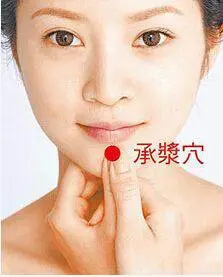 Location: At the center of the philtrum. Indication: Pediatric anorexia. Technique: Moderate pressure kneading for3-5minutes. 22. Acupuncture Point: Yi Niao Dian (Hand Needle Point) Location: At the midpoint of the transverse crease of the little finger. Indication: Pediatric enuresis (Kidney deficiency). Technique: Light pressing and kneading for1-3minutes. 23. Acupuncture Point: Tian Zhu (Foot Tai Yang Bladder Meridian)
Location: At the center of the philtrum. Indication: Pediatric anorexia. Technique: Moderate pressure kneading for3-5minutes. 22. Acupuncture Point: Yi Niao Dian (Hand Needle Point) Location: At the midpoint of the transverse crease of the little finger. Indication: Pediatric enuresis (Kidney deficiency). Technique: Light pressing and kneading for1-3minutes. 23. Acupuncture Point: Tian Zhu (Foot Tai Yang Bladder Meridian)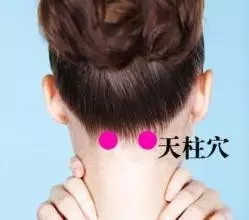 Location: In the depression behind the hairline, five fen lateral to the large muscle of the neck, one and a half cun lateral to Ya Men. Indication: Throat swelling and pain. Technique: Light kneading and pressing for24minutes. 24. Acupuncture Point: Tai Chong (Foot Jue Yin Liver Meridian, Shu Point, Yuan Point)
Location: In the depression behind the hairline, five fen lateral to the large muscle of the neck, one and a half cun lateral to Ya Men. Indication: Throat swelling and pain. Technique: Light kneading and pressing for24minutes. 24. Acupuncture Point: Tai Chong (Foot Jue Yin Liver Meridian, Shu Point, Yuan Point)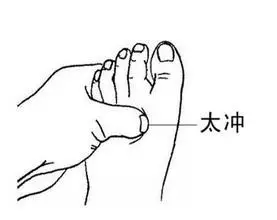 Location: One and a half cun above the gap between the first and second toes on the dorsum of the foot. Indication: Nosebleed.Technique: Direct pressing with force. 25. Acupuncture Point: Shang Ying Xiang (Extraordinary Point)
Location: One and a half cun above the gap between the first and second toes on the dorsum of the foot. Indication: Nosebleed.Technique: Direct pressing with force. 25. Acupuncture Point: Shang Ying Xiang (Extraordinary Point) Location: Five fen below the inner canthus of the eye. Indication: Sinusitis. Technique: Knead for1-2minutes. 26. Acupuncture Point: Shao Ze (Hand Tai Yang Small Intestine Meridian, Jing Point)
Location: Five fen below the inner canthus of the eye. Indication: Sinusitis. Technique: Knead for1-2minutes. 26. Acupuncture Point: Shao Ze (Hand Tai Yang Small Intestine Meridian, Jing Point) Location: On the ulnar side of the little finger, 0.1 cun from the nail. Indication: Acute conjunctivitis. Technique: Strong pinching with the thumb. 27. Acupuncture Point: Da Shu (Foot Tai Yang Bladder Meridian)
Location: On the ulnar side of the little finger, 0.1 cun from the nail. Indication: Acute conjunctivitis. Technique: Strong pinching with the thumb. 27. Acupuncture Point: Da Shu (Foot Tai Yang Bladder Meridian)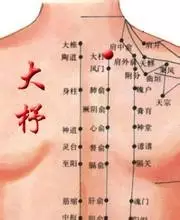 Location: One and a half cun below the first thoracic vertebra. Indication: Stye. Technique: Direct pressing diagonally towards the cervical vertebra. 28. Acupuncture Point: Guan Xin Point Location: At the midpoint of the line connecting the left foot’s Jie Xi point (Foot Tai Yang Bladder Meridian) to the second and third toe bones. Indication: Coronary heart pain, pain relief. Technique: Press with the fingertip or a ballpoint pen for5minutes. 29. Acupuncture Point: Yuan Jun Point Location: At the center of the palm of the left hand, below the middle finger joint. Indication: Coronary heart disease, angina pectoris. Technique: Point kneading with one-finger Zen method.30. Acupuncture Point: Guan Yuan (Ren Meridian, Small Intestine Mu Point)
Location: One and a half cun below the first thoracic vertebra. Indication: Stye. Technique: Direct pressing diagonally towards the cervical vertebra. 28. Acupuncture Point: Guan Xin Point Location: At the midpoint of the line connecting the left foot’s Jie Xi point (Foot Tai Yang Bladder Meridian) to the second and third toe bones. Indication: Coronary heart pain, pain relief. Technique: Press with the fingertip or a ballpoint pen for5minutes. 29. Acupuncture Point: Yuan Jun Point Location: At the center of the palm of the left hand, below the middle finger joint. Indication: Coronary heart disease, angina pectoris. Technique: Point kneading with one-finger Zen method.30. Acupuncture Point: Guan Yuan (Ren Meridian, Small Intestine Mu Point)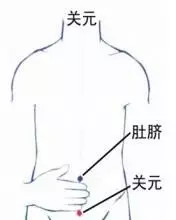 Location: Four horizontal fingers below the navel, on the midline. Indication: Insomnia. Technique: Knead while half-sitting for100-200times, soak feet in 45℃water, press and knead Yong Quan point200times.31Acupuncture Point: Si Bai (Foot Yang Ming Stomach Meridian)
Location: Four horizontal fingers below the navel, on the midline. Indication: Insomnia. Technique: Knead while half-sitting for100-200times, soak feet in 45℃water, press and knead Yong Quan point200times.31Acupuncture Point: Si Bai (Foot Yang Ming Stomach Meridian)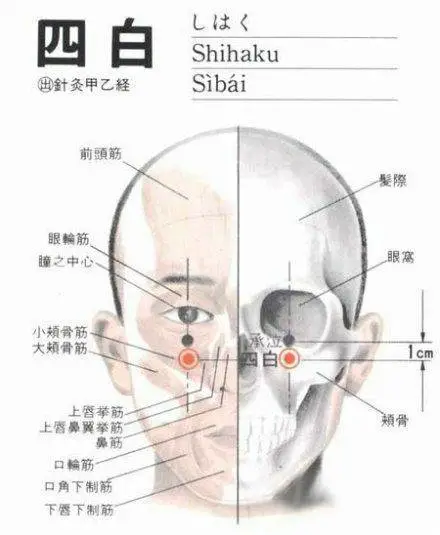 Location: When looking straight ahead, directly below the pupil, in the depression of the infraorbital foramen. Indication: Constipation. Technique: Knead the abdomen from right to left for200times; during defecation, press both sides of Si Bai and Chang Qiang points (located in the depression at the end of the coccyx). 32Acupuncture Point: An Mian (Extraordinary Point)
Location: When looking straight ahead, directly below the pupil, in the depression of the infraorbital foramen. Indication: Constipation. Technique: Knead the abdomen from right to left for200times; during defecation, press both sides of Si Bai and Chang Qiang points (located in the depression at the end of the coccyx). 32Acupuncture Point: An Mian (Extraordinary Point) 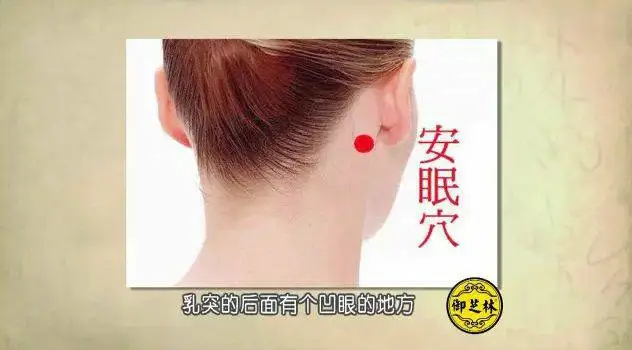 Location: At the midpoint of the line between Yi Feng (Hand Shao Yang San Jiao Meridian) and Feng Chi (Foot Shao Yang Gallbladder Meridian). Indication: Insomnia, migraine. Technique: Moderate pressing. 33Acupuncture Point: Qian Zheng (Extraordinary Point)
Location: At the midpoint of the line between Yi Feng (Hand Shao Yang San Jiao Meridian) and Feng Chi (Foot Shao Yang Gallbladder Meridian). Indication: Insomnia, migraine. Technique: Moderate pressing. 33Acupuncture Point: Qian Zheng (Extraordinary Point)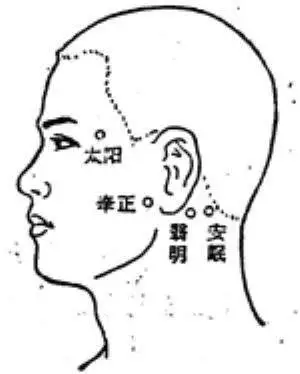 Location: Five fen to one cun in front of the earlobe. Indication: Facial nerve paralysis, oral ulcers. Technique: Moderate diagonal pressing, (for oral ulcers, add small intestine reflex area). 34Acupuncture Point: Shi Mian (Extraordinary Point, Sole)
Location: Five fen to one cun in front of the earlobe. Indication: Facial nerve paralysis, oral ulcers. Technique: Moderate diagonal pressing, (for oral ulcers, add small intestine reflex area). 34Acupuncture Point: Shi Mian (Extraordinary Point, Sole) 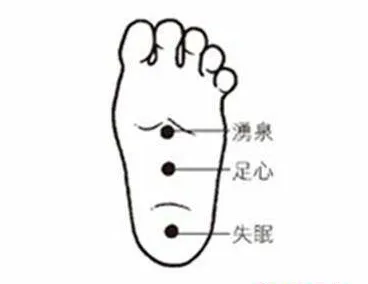 Location: At the midpoint of the heel on the sole of the foot. Indication: Insomnia, heel pain. Technique: Strong pressure. 35Acupuncture Point: Shan Yao (Foot Tai Yang Bladder Meridian)
Location: At the midpoint of the heel on the sole of the foot. Indication: Insomnia, heel pain. Technique: Strong pressure. 35Acupuncture Point: Shan Yao (Foot Tai Yang Bladder Meridian)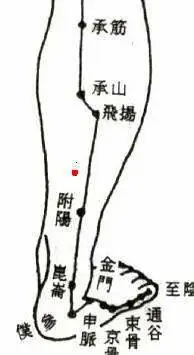 Location: On the calf, at the intersection of the upper third and middle third of the line connecting Cheng Shan (Foot Tai Yang Bladder Meridian) and Kun Lun (Foot Tai Yang Bladder Meridian). Indication: Lumbar sprain, also known as “shaking waist”. Technique: Point pressing. The patient lies face down, the practitioner finds the “shaking waist” points on both sides, then uses both thumbs to press sharply on the points, pressing and releasing three to five times, then gently knead for one to three minutes until the patient can tolerate and slightly sweat. Finally, gently massage the lower back for a few minutes to finish the treatment. After one treatment, the patient often shows significant improvement, and after one to four treatments, the lumbar pain symptoms will disappear. 36Acupuncture Point: Luo Zhen (Extraordinary Point)
Location: On the calf, at the intersection of the upper third and middle third of the line connecting Cheng Shan (Foot Tai Yang Bladder Meridian) and Kun Lun (Foot Tai Yang Bladder Meridian). Indication: Lumbar sprain, also known as “shaking waist”. Technique: Point pressing. The patient lies face down, the practitioner finds the “shaking waist” points on both sides, then uses both thumbs to press sharply on the points, pressing and releasing three to five times, then gently knead for one to three minutes until the patient can tolerate and slightly sweat. Finally, gently massage the lower back for a few minutes to finish the treatment. After one treatment, the patient often shows significant improvement, and after one to four treatments, the lumbar pain symptoms will disappear. 36Acupuncture Point: Luo Zhen (Extraordinary Point)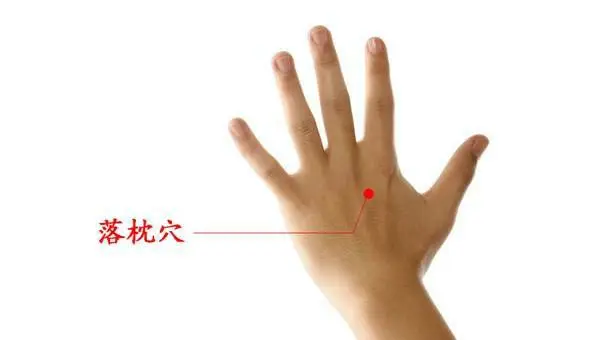 Location: On the back of the hand, between the second and third metacarpals, about 0.5 cun behind the metacarpophalangeal joint. Indication: Stiff neck. Technique: The Luo Zhen point is on the back of the hand. On the back of the hand, between the bones of the index and middle fingers, touch towards the wrist, from the point where the bones narrow to the end of the fingers, about one finger width up, press, and there will be a strong painful point, which is the Luo Zhen point. Use the fingertip or the ballpoint pen (not the pen tip) to press on this point, applying slight pressure to stimulate it, and the stiff neck will become much more relaxed. 37Acupuncture Point: Tai Yang (Extraordinary Point)
Location: On the back of the hand, between the second and third metacarpals, about 0.5 cun behind the metacarpophalangeal joint. Indication: Stiff neck. Technique: The Luo Zhen point is on the back of the hand. On the back of the hand, between the bones of the index and middle fingers, touch towards the wrist, from the point where the bones narrow to the end of the fingers, about one finger width up, press, and there will be a strong painful point, which is the Luo Zhen point. Use the fingertip or the ballpoint pen (not the pen tip) to press on this point, applying slight pressure to stimulate it, and the stiff neck will become much more relaxed. 37Acupuncture Point: Tai Yang (Extraordinary Point)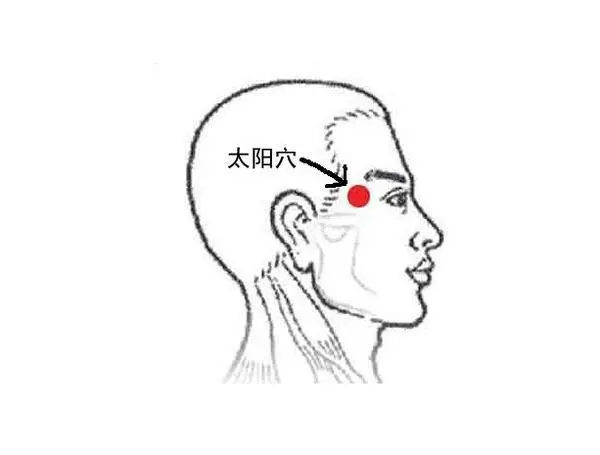 Location: In the temporal region, in the depression about one horizontal finger behind the eyebrow tip and the outer canthus of the eye. Indication: Headache. Technique: During a headache attack, the patient can use both index fingers to press on both sides of the Tai Yang point (located in the depression about one cun behind the eyebrow tip and the outer canthus), pressing until a feeling of pressure occurs, and rotate in a clockwise direction for about1minute, the headache can be relieved. 38Acupuncture Point: He Gu (Hand Yang Ming Large Intestine Meridian)
Location: In the temporal region, in the depression about one horizontal finger behind the eyebrow tip and the outer canthus of the eye. Indication: Headache. Technique: During a headache attack, the patient can use both index fingers to press on both sides of the Tai Yang point (located in the depression about one cun behind the eyebrow tip and the outer canthus), pressing until a feeling of pressure occurs, and rotate in a clockwise direction for about1minute, the headache can be relieved. 38Acupuncture Point: He Gu (Hand Yang Ming Large Intestine Meridian)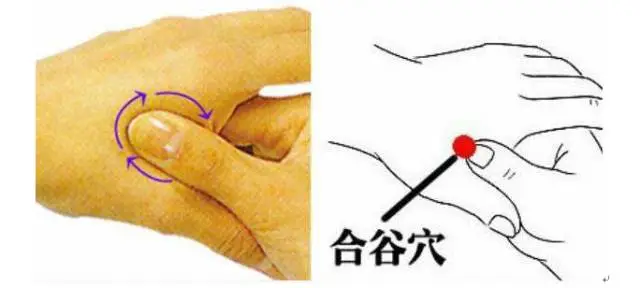 Location: To locate this point, the patient should place their wrist against the palm, naturally half-clenching their fist, He Gu point is located on the back of the hand, at the midpoint of the second metacarpal, on the thumb side. (Alternatively, on the back of the hand, between the first and second metacarpals, at the radial side of the second metacarpal), another simple way to find it: when the thumb and index finger are spread at a 45-degree angle, it is located at the intersection of the extended line of the bones. Indication: Syncope. Technique: In cases of heat stroke, stroke, or collapse, if the patient suddenly faints and loses consciousness, with pale complexion and profuse sweating, pressing the He Gu point (located at the tiger’s mouth) with the thumb for2to3minutes will generally relieve the condition. 39Acupuncture Point: Ren Zhong (Ren Meridian)
Location: To locate this point, the patient should place their wrist against the palm, naturally half-clenching their fist, He Gu point is located on the back of the hand, at the midpoint of the second metacarpal, on the thumb side. (Alternatively, on the back of the hand, between the first and second metacarpals, at the radial side of the second metacarpal), another simple way to find it: when the thumb and index finger are spread at a 45-degree angle, it is located at the intersection of the extended line of the bones. Indication: Syncope. Technique: In cases of heat stroke, stroke, or collapse, if the patient suddenly faints and loses consciousness, with pale complexion and profuse sweating, pressing the He Gu point (located at the tiger’s mouth) with the thumb for2to3minutes will generally relieve the condition. 39Acupuncture Point: Ren Zhong (Ren Meridian) 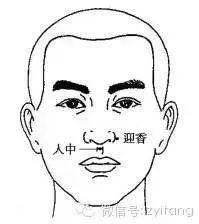 Location: This point is located on the face, at the intersection of the upper third and middle third of the Ren Zhong groove. Indication: Shock. Technique: Stimulating the Ren Zhong point has the effect of raising blood pressure and stimulating the respiratory center. In cases of stroke, heat stroke, poisoning, or allergy, if the patient suddenly becomes unconscious, stops breathing, has low blood pressure, or goes into shock, pressing the Ren Zhong point with the fingertip can serve as a first aid measure. 40Acupuncture Point: Lao Gong (Hand Jue Yin Pericardium Meridian, Ying Point)
Location: This point is located on the face, at the intersection of the upper third and middle third of the Ren Zhong groove. Indication: Shock. Technique: Stimulating the Ren Zhong point has the effect of raising blood pressure and stimulating the respiratory center. In cases of stroke, heat stroke, poisoning, or allergy, if the patient suddenly becomes unconscious, stops breathing, has low blood pressure, or goes into shock, pressing the Ren Zhong point with the fingertip can serve as a first aid measure. 40Acupuncture Point: Lao Gong (Hand Jue Yin Pericardium Meridian, Ying Point)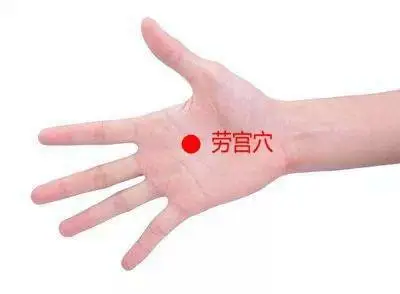 Location: Lao Gong point is located in the palm of the hand, between the second and third metacarpals, closer to the third metacarpal, at the tip of the middle finger when the fist is clenched. Indication: Hypertension. Technique: In cases of hypertension due to anger, rage, excitement, or fatigue, blood pressure can rise sharply, posing a significant threat to the patient’s life. At this time, pressing the Lao Gong point (located in the palm between the middle and ring fingers) can gradually restore blood pressure to normal. 41Acupuncture Point: Shao Shang (Hand Tai Yin Lung Meridian, Jing Point)
Location: Lao Gong point is located in the palm of the hand, between the second and third metacarpals, closer to the third metacarpal, at the tip of the middle finger when the fist is clenched. Indication: Hypertension. Technique: In cases of hypertension due to anger, rage, excitement, or fatigue, blood pressure can rise sharply, posing a significant threat to the patient’s life. At this time, pressing the Lao Gong point (located in the palm between the middle and ring fingers) can gradually restore blood pressure to normal. 41Acupuncture Point: Shao Shang (Hand Tai Yin Lung Meridian, Jing Point) 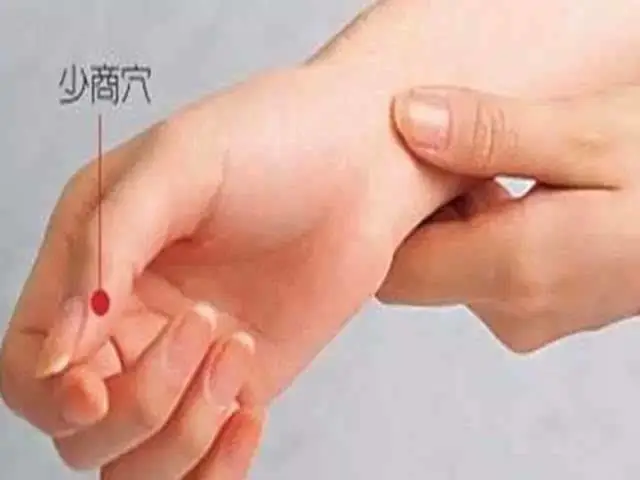 Location: Shao Shang point is located on the outer side of the thumb, one fen from the nail corner. Indication: Hiccups. Technique: During hiccups, the patient can press the Shao Shang point with the thumb and index finger until a feeling of soreness occurs, for about half a minute to1minute, hiccups can be stopped. 42Acupuncture Point: Nei Guan (Hand Jue Yin Pericardium Meridian, Luo Point, Meeting Point of Eight Meridians, connects to Yin Wei Meridian)
Location: Shao Shang point is located on the outer side of the thumb, one fen from the nail corner. Indication: Hiccups. Technique: During hiccups, the patient can press the Shao Shang point with the thumb and index finger until a feeling of soreness occurs, for about half a minute to1minute, hiccups can be stopped. 42Acupuncture Point: Nei Guan (Hand Jue Yin Pericardium Meridian, Luo Point, Meeting Point of Eight Meridians, connects to Yin Wei Meridian)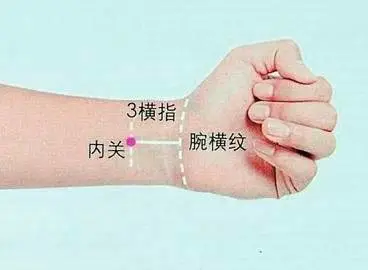 Location: On the palmar side of the forearm, two cun above the wrist crease, between the flexor carpi radialis and the flexor carpi ulnaris tendons. Indication: Stops vomiting. Technique: During vomiting, pressing the Nei Guan point with the middle finger can stop the vomiting. The Nei Guan point is located two cun above the wrist crease, between the two tendons, pressing until a feeling of soreness and swelling occurs indicates that the point has been hit, and vomiting will stop in about1minute. 43Acupuncture Point: Tian Shu (Foot Yang Ming Stomach Meridian, Large Intestine Mu Point) Location: In the middle of the abdomen, two cun from the navel. Indication: Constipation.Technique: For constipation, during defecation, press the left Tian Shu point (located two cun to the left of the navel) with the left middle finger until a significant feeling of soreness occurs, hold it for about1minute, then hold your breath to increase abdominal pressure, and you can defecate. 44Acupuncture Point: Jiao Hou Gen Location: In the depression between the ankle joint and the heel bone. Indication: Stops nosebleeds.Technique: When the nose is bleeding, immediately pinch the heel (in the depression between the ankle joint and the heel bone) with the thumb and index finger, pinch the right heel for left nosebleed, and pinch the left heel for right nosebleed, to stop the bleeding. 45Acupuncture Point: Yang Ling Quan (Foot Shao Yang Gallbladder Meridian, He Point, Lower He Point, Meeting Point of Eight Hui)
Location: On the palmar side of the forearm, two cun above the wrist crease, between the flexor carpi radialis and the flexor carpi ulnaris tendons. Indication: Stops vomiting. Technique: During vomiting, pressing the Nei Guan point with the middle finger can stop the vomiting. The Nei Guan point is located two cun above the wrist crease, between the two tendons, pressing until a feeling of soreness and swelling occurs indicates that the point has been hit, and vomiting will stop in about1minute. 43Acupuncture Point: Tian Shu (Foot Yang Ming Stomach Meridian, Large Intestine Mu Point) Location: In the middle of the abdomen, two cun from the navel. Indication: Constipation.Technique: For constipation, during defecation, press the left Tian Shu point (located two cun to the left of the navel) with the left middle finger until a significant feeling of soreness occurs, hold it for about1minute, then hold your breath to increase abdominal pressure, and you can defecate. 44Acupuncture Point: Jiao Hou Gen Location: In the depression between the ankle joint and the heel bone. Indication: Stops nosebleeds.Technique: When the nose is bleeding, immediately pinch the heel (in the depression between the ankle joint and the heel bone) with the thumb and index finger, pinch the right heel for left nosebleed, and pinch the left heel for right nosebleed, to stop the bleeding. 45Acupuncture Point: Yang Ling Quan (Foot Shao Yang Gallbladder Meridian, He Point, Lower He Point, Meeting Point of Eight Hui)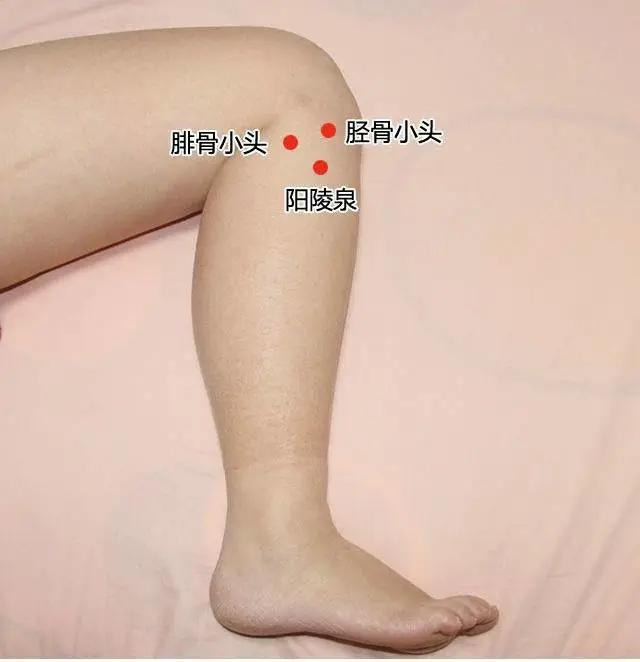 Location: On the outer side of the calf, in the depression below the head of the fibula. Indication: Gallbladder colic.Technique: During gallbladder inflammation or gallstones, severe colicky pain may occur in the upper right abdomen. The patient can use the thumb to massage the Yang Ling Quan point, located one cun below the head of the fibula on the outer side of the right calf, for two minutes to achieve good pain relief. 46Acupuncture Point: San Yin Jiao (Foot Tai Yin Spleen Meridian)
Location: On the outer side of the calf, in the depression below the head of the fibula. Indication: Gallbladder colic.Technique: During gallbladder inflammation or gallstones, severe colicky pain may occur in the upper right abdomen. The patient can use the thumb to massage the Yang Ling Quan point, located one cun below the head of the fibula on the outer side of the right calf, for two minutes to achieve good pain relief. 46Acupuncture Point: San Yin Jiao (Foot Tai Yin Spleen Meridian)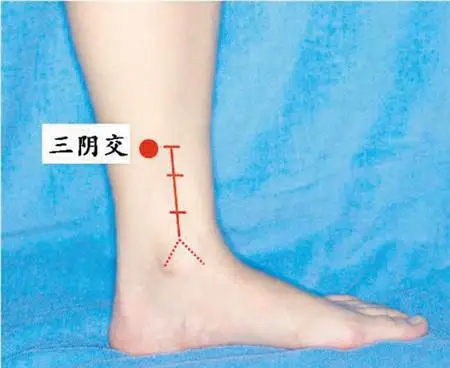 Location: On the inner side of the calf, three cun above the tip of the inner ankle, at the posterior edge of the tibia. Indication: Renal colic.Technique: During renal colic, the patient can use the thumb to knead the San Yin Jiao point (located three cun above the inner ankle at the posterior edge of the tibia) for 3 to 5 minutes, which will relieve the renal colic. 47Acupuncture Point: Zhi Yang (Du Meridian)
Location: On the inner side of the calf, three cun above the tip of the inner ankle, at the posterior edge of the tibia. Indication: Renal colic.Technique: During renal colic, the patient can use the thumb to knead the San Yin Jiao point (located three cun above the inner ankle at the posterior edge of the tibia) for 3 to 5 minutes, which will relieve the renal colic. 47Acupuncture Point: Zhi Yang (Du Meridian)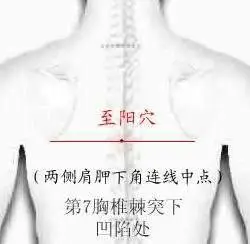 Location: In the midline of the back, in the depression below the seventh thoracic vertebra. Indication: Relieves angina pectoris.Technique: Angina pectoris often accompanies a feeling of pressure and suffocation in the chest. At this time, pressing the Zhi Yang point (located below the seventh thoracic vertebra on the back, the patient sits with their head down and arms hanging, the intersection of the lower edges of the scapulae with the spine is this point), applying pressure for3to6minutes will relieve angina pectoris.
Location: In the midline of the back, in the depression below the seventh thoracic vertebra. Indication: Relieves angina pectoris.Technique: Angina pectoris often accompanies a feeling of pressure and suffocation in the chest. At this time, pressing the Zhi Yang point (located below the seventh thoracic vertebra on the back, the patient sits with their head down and arms hanging, the intersection of the lower edges of the scapulae with the spine is this point), applying pressure for3to6minutes will relieve angina pectoris.
